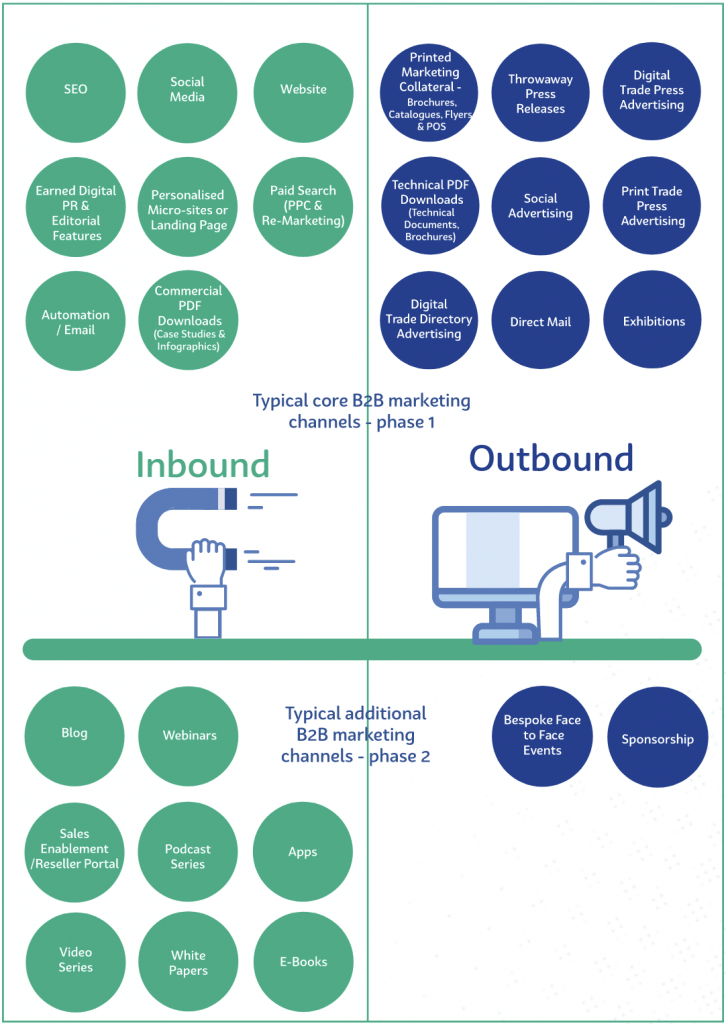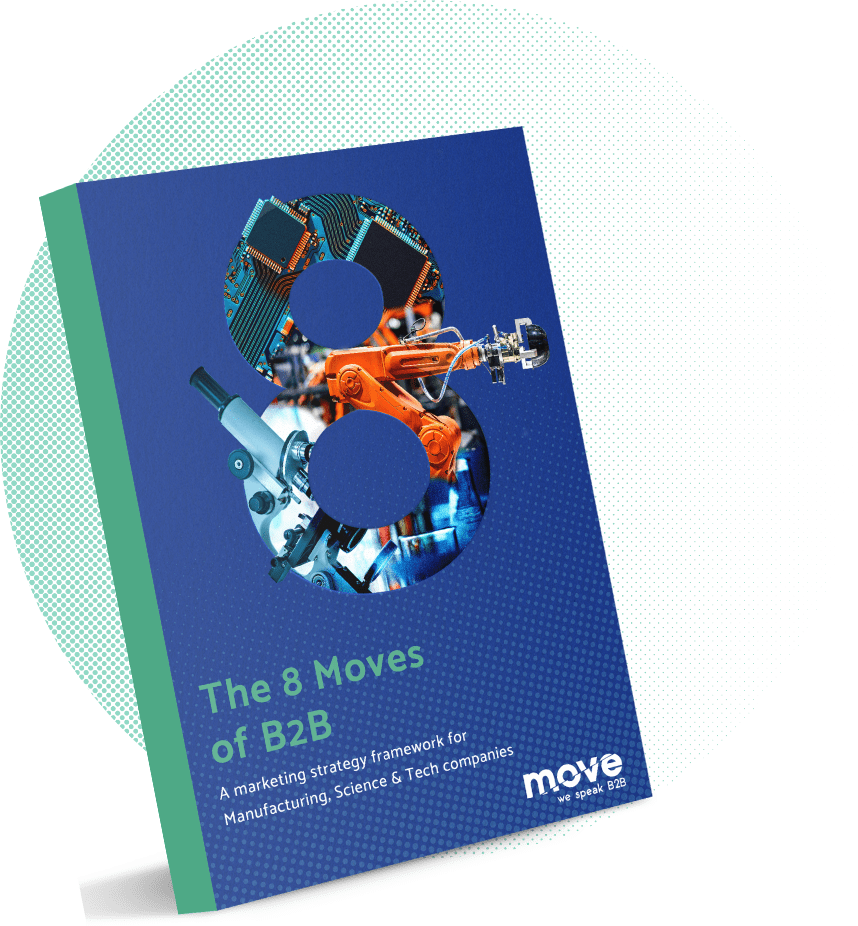
Creating A SuccessfulB2B Marketing Channel Mix
Step 4: Media & marketing channel selection
4.1 – What does the spectrum of typical marketing channels look like in B2B?
Back when I started my marketing career in the aircraft tyre sector twenty years ago, the range of channels available was a fraction of what it has evolved into today. Exhibitions were a major force, print trade publications represented the key communications channel and the digital landscape was still in its infancy, with no more than basic websites having been developed at that stage, even for industrial super-brands such as Michelin. As a result, building a communications or product launch campaign was quite restrictive in terms of the techniques and tools available.
Although on the one hand, this was a negative there’s no question that it did encourage creative, out of the box thinking. On one occasion while
leading a divisional EMEA (Europe, Middle East and Africa) marketing team at Ingersoll Rand in 2005, I visited the US headquarters with the rest
of my team for a distributor conference which included live demos of a brand new innovation in Oil Free Air Compressors. The product in question was essentially a huge, beige box about the size of a garden shed with thousands of intricate component parts within it. With a market value of more than six figures, it would be a hugely profitable product line for the company.
In the US, the sales team could easily invite all its nationwide distributors to a central location to showcase the technology in action. In Europe that wouldn’t be quite so straightforward. On returning from the conference we came up with a concept of housing the product in a 40-foot shipping container hooked up to all the associated peripherals. We then linked it up to a couple of screens which we used to show pressure variation in the system and mimicked air leakage scenarios to show the potential for energy savings. Over a 12-month period, we proceeded to use a flatbed truck to drive this simulation unit to all corners of Europe in order to give demonstrations to local distributors, direct salespeople and potential customers. We cancelled around half of that year’s exhibition activity to pay for the production and logistics needed to enable this targeted solution. The result was that we outperformed the year 1 sales target by more than 300%.
Fast forward to 2020 and the huge expanse of marketing channels available – we are now living in an era of marketing channel saturation; a point to which anyone having seen the famous “Martech 8000” marketing technology landscape chart10 will happily testify. B2B brands that still rely only on the outdated techniques of the late 2000s and think that a few exhibitions a year plus several trade press adverts at regular intervals and the odd print brochure run will suffice are inevitably getting left behind in this new era.
In terms of an overall understanding of the new channels available it’s important not to confuse key category types, especially when it comes to the most popular modern approaches. Although content marketing and inbound marketing in particular have a lot in common, there are some key differences. Content marketing focuses on the creation and distribution of content across multiple channels – for example, writing a guide, sharing it on social media and ensuring that it is read and shared by those who will find it applicable. Inbound marketing, meanwhile,
focuses on methodologies – e.g. making a website, and the content on it, attractive enough to compel some kind of action by the visitor, whether that’s via a purchase, the completion of a form, or just a follow on social media. While content marketing is focused on building relationships through content, it sits under the umbrella of inbound marketing which is a “bigger picture” activity that uses many activities and methods to eventually inspire a customer to take action. Digital marketing, by contrast, represents the core platforms or marketing channels used to connect.
Twenty years ago, the range of channels available was a fraction of what it has evolvedinto today
B2B Media Channel Selection

When assessing the marketing channels available you should always keep the core drivers of a B2B buyer at the heart of any plan. They are fundamentally driven by; the product’s lifetime value or ROI and how the business will benefit; technical characteristics and tangible benefits; a desire to be educated; detailed technical content; numerous decision makers in the buying process; and a longer buying cycle and contract period. All of these aspects lend themselves to more of a lead nurturing and drip feed approach, which coaxes the prospect in and then reinforces the message through a carefully orchestrated multi-channel approach.
While at Knauf Insulation in the late 2000s, the spectrum of channels was beginning to increase and there was a healthy and flexible enough annual budget (over £1 million) to experiment. As a team, we tried out a number of different approaches, from cutting edge interactive features on our trade show stands through to testing out new digital approaches that were beginning to emerge. The most successful
piece of marketing that we produced though was geared around thought leadership and effective implementation of something similar to the “Hero/ Hub/ Help” approach outlined in the previous step, albeit several years before that method rose to prominence in 2014. Over a 6-month period, we produced a detailed comparison guide to every available insulation material, covering both Knauf and competitor material solutions, which we then disseminated in both digital and print form. The content was broken up into smaller chunks for editorial features and press releases as well as videos, infographics and social posts. As a piece of thought leadership positioning it caught our competitors off guard and gave us a huge advantage in the highly competitive insulation marketplace.
4.2. Building a modern B2B channel mix
A look around at the state of the current marketing landscape gives an indication of the scale of the challenge when it comes to selecting the right mix of marketing channels. As of January 2020, there were 1.74 billion websites in the world – that’s a fair bit of competition for attention. It’s also a 700% increase on 2010, so we’ve come a long way in the last 10 years.11 The global content marketing industry has doubled in the last 5 years alone to more than £300 billion. What does that look like in real time? Every day, over 4.4 million blog posts are published online along with over 700 million tweets, 4 million hours of video content and there are also 5 billion worldwide internet searches every day. Even before you get to the segmentation and persona focused targeting approaches of the B2B marketplace, that’s a lot of needles in one almighty haystack!
The B2B buyer’s journey has also been completely transformed in recent years: there are more people involved in the B2B purchase decision; the modern B2B buyer does their own research and it’s usually online; and most B2B buyers now twist and turn through the marketing funnel, looping back and repeating at least one or more tasks in the journey of Awareness-Consideration-Decision-Experience. Research carried out by Gartner in March 2020 suggests that B2B marketing leaders now allocate the highest proportion (11.6%) of their overall budgets to the company website and a total of 73% of the budget goes on digital activity.
B2B marketing leaders now allocate 73% of the budget to digital activity
There are over a hundred categorised top level, broad channel marketing types i.e. general grouping such as “Social Media” rather than than individual channel such as “LinkedIn”. This presents a complex challenge to B2B Marketers when it comes to attempting to define the mix of channel types to be used. A few key areas should be addressed in this respect:
- What is the cost profile/barrier to entry of a particular channel? “Very high/ high/ medium/ low/ very low”
- Review relative performance of channels currently used and rank according to “very high/ high/medium/ low/very low” – there are numerous free of charge MarTech tools that can guide you to benchmark stats for a particular industry sector
- Rank what proportion of competitors already use the channel
- Assess whether there are any new channels that competitors are using that may add value to the mix by effectively targeting key buyer personas
- Score potential channels from 1 to 10 for market fit and potential returns
- Is the channel mainly used for drip feed, one off material or both? Also consider how this fits with the approach defined in Step 3 of the model
- Apply weightings to each category above and select new mix of channels
When selecting the optimal mix of channels, it’s also useful to align the mix with the different stages of a modern B2B buyer’s journey, which broadly maps out as follows:
- Awareness stage
- Consideration stage
- Decision stage
- Experience stage
In the modern B2B journey, research and advisory company Gartner has suggested an expanded version of this process with customers engaging in a series of loops around, back and through the different stages: Problem identification/ Solution exploration/ Requirements building/ Supplier selection/ Validation/ Consensus creation. Using either structure our fundamental challenge as B2B marketers is therefore to develop, refine and place content that will respond to each of the different steps accordingly.
The Ultimate B2B Marketing Guide

